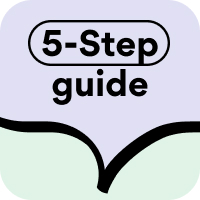The Ultimate SaaS Conferences Calendar!
Join today and pay no transaction fees for 60 days.
Changes in B2B Buying Process and Conclusions for SaaS Companies in 2023

B2B purchase is a complex process that includes a supplier’s hard work in sales and marketing, and a series of steps from a buyer. B2B buyer journey has transformed in recent years, leaving businesses no choice but to adapt to the changes in buyer behavior. Today we will look into the B2B buying journey, how it has changed over time, what are the implications of these changes, and how to attract B2B buyers in this new reality.

Freebie
5-Step Guide on Revenue Growth for Bootstrapped & Seed Stage Startups in 2023
What is a B2B Buyer Journey?
B2B buyer journey is the complete process your buyer will walk through to make a purchase, starting from initial awareness of your brand, and the assessment of your offer, to finally making the decision to buy your product or service.
Making a purchase from your company for the first time is the primary step for new customers to start working with you, and for you it is a crucial phase — there is vast potential for driving organic growth from your potential future customers through cross-sell and upsell.
Understanding where your customers are in the buyer journey offers you one of the most important marketing tools. With this knowledge, you can choose the right marketing tactics, develop the most effective messaging strategy, and even create quality content to reach your buyers, right where they are in the journey.
B2B and B2C Buyer Journeys are Different
In the B2C market, potential clients are typically one individual or a group of individuals with particular needs. Their choice is usually influenced by convenience of purchase or their personal financial ability to buy your product or service. Connections with a B2C buyer are formed over a shorter period of time, with sales and marketing directed to a broad target audience.
In the B2B market, the concept of a customer has to be understood differently, as it often includes several stakeholders. They may have different interests, concerns, intentions and objectives. Stakeholders can be anyone from the executive buyer to the end customer, and they, for their part, have to think of the company’s related matters, such as procurement and legal issues. Connections with B2B buyers are formed over a longer period of time, with sales, marketing, and account management resources directed precisely at that particular client. In a B2B journey you build relationships not only with the final decision maker, but with all stakeholders. And this strong connection you create will bring your business to success.
Even though the stages in the B2B buying process may appear very alike to those in B2C, it’s much longer and much more significant for your company, because each B2B purchasing decision does affect your business.
Changes in B2B Buying Journey
In the last few years, the B2B buying process has gained a new understanding — B2B companies struggle with customers’ sales not because of marketing failure, but due to customers’ inability to buy. This buying failure occurs due to several factors: salespeople cannot influence buyers decisions as they could do before, the amount of options to be compared by buyers is growing, all of the decision makers have to come to a consensus, buyer behavior is not linear. And, of course, the recent downturn added financial reasons to customers’ inability to buy.
It has become much easier for B2B customers to gather information on their own, through digital channels that deliver firsthand information with a click of a mouse. Buyers do lots of research before deciding on a purchase. With this easily accessible information sellers have less possibility and opportunities to control or even influence consumers’ decisions.
B2B purchases need a very high level of consensus. B2B purchase decisions are often made by approximately eight decision makers, who must come to an agreement based on four or five pieces of information they have gathered independently, and approve a purchase.
With more stakeholders engaged in the process, there are undoubtedly more opinions and points of view to take into consideration. The decision can be influenced by a person’s job position, level of influence and department in the company, which leads to a longer and a more complex decision-making process. Besides, there may be external stakeholders who are also affecting the purchase.
At the same time, new technologies, products, suppliers and services are formed every day, so the number of options and solutions to be considered by buyers is growing. This makes making purchases very complex and increasingly difficult for customers.
B2B Buyer Set of Jobs
There are six B2B buying jobs that your clients must complete in order to successfully finalize a purchase, according to Gartner. A better understanding of these stages allows you to help your customers go through a complicated purchase.
- Problem Identification. “We need to do something.”
This stage of the B2B buyer journey is also called the awareness stage. A business at this stage has just realized they have an issue that absolutely needs to be solved. At this point, they’re not even looking for your products or services, they are just identifying the root of the problem.
Be present and offer the expertise for them to fully comprehend the issue, the cost of the problem to their organization, and the return on investment of the solution, thus later you will likely be their solution provider.
2. Solution Exploration. “What’s out there to solve our problem?”
Once the issue is identified, the client first analyzes how solving the problem would affect their business, and should they solve the problem at all.
Then, they begin to search for the right product or service as a solution. In this stage, the B2B buyer researches possible options and compares costs, quality of goods, shipping options, variety of products, and so on.
Likely, many buyers will search on digital channels such as brand websites, search engines, white papers, B2B marketplaces and social media. Which is why it’s critical to your company that your B2B business keeps a constant online presence.
3. Requirements Building. “What exactly do we need the purchase to do?”
After a B2B buyer has searched for a product or service and had an apprehension of the speculations and prices associated with the solution, they will narrow down their choices.
Your company shouldn’t wait for a request from a B2B buyer for your plan of how you can help fulfill their requirements. Contact your potential clients ahead of time: create a checklist, specify the timelines, and estimate the impact of your solution.
4. Supplier Selection. “Does this do what we want it to do?”
By this stage, a B2B buyer has a better idea of what they’re looking for in a product or service, and has created a list of potential suppliers. Now they need to choose which one is the best for their business. As a part of the evaluation process, business buyers set up specific business objectives and internal goals. It’s crucial for them to evaluate the effect the solution will have on their business.
You need to make sure your company is always present in industry publications as an acknowledged supplier of the products and services that the buyer now is looking for. This is an important stage for your marketing team.
5. Validation. “We think we know the right answer, but we need to be sure.”
The next stage is validation. By now, a B2B buyer has made the choice, but still they need to justify it. This usually means asking the supplier to deliver references or a presentation to get the approval of senior management.
Typically, the person who confirms the purchase is not the one doing the research, so you need to be ready to answer difficult questions and demonstrate that your business provides the best solution for the buyer. Previous cases that correlate with your customer’s industry are the best strategy to let your clients clearly see that your solution is the most efficient way of solving their problem.
6. Consensus Creation. “We need to get everyone on board.”
At the last stage, a B2B buyer has made the decision to purchase a company’s solution and is in the process of signing the contract. Commonly, the buying decision is made by a consensus of a leadership team.
In B2B business, we rarely work with the decision-maker. Experienced salespeople know it well and do their best to present the solution, set their company apart from the competition, and help the business pass through the approval process.
The B2B Buying Journey is Not Linear
These six buying jobs rarely go in a predictable, linear order. They don’t run consecutively, but more or less simultaneously. Going through a purchase, B2B customers revisit each of these jobs at least once. Businesses often change their requirements, and expand or narrow their focus as they proceed with a purchase.
All of this bouncing around and going from one job to another means that buyers appreciate suppliers that speed up and ease the process of going through the purchase. Customers who received advanced experience of purchase buy a bigger deal. To succeed in this B2B buying environment, suppliers should concentrate on providing clients with information that is explicitly intended to enable buyers to complete their buying jobs.
Implications of New B2B Buyer Behavior
- Sales Representatives are Just One of the Channels
Nowadays, buyers are experienced and well aware of the different options on the market. Clients are mainly channel-agnostic when seeking the information needed to accomplish their goal. Plenty of first-hand sources are just a click away. Buyers prefer their own research over connecting with a company’s sales team. As a result, salespeople are not the only channel to customers, but just one of the ways to get information. Thus, maintaining in-person and digital channels is critical for providing your customers with the information in the way they actually buy. That makes content creation more important than ever, as it attracts new B2B customers and can fast-track the purchasing journey.
- Deceiving Pipeline Reports
Most salespeople organize activity around a linear pipeline, seeking to move opportunities from one stage to the next. However, customers almost never follow a straight path. Most B2B buyer journeys go back and forth, zigzag, change requirements, struggle to achieve consensus, and can be abandoned at any moment. For B2B customers purchase progress as a job completion is much more important than its linear stage progression. Therefore, while sales reports show a majority of buyers stuck in, let’s say, validation stage, there is no way of knowing for sure through a linear supplier-centric sales funnel where exactly customers are truly struggling to move forward in the journey. We know that the stage can change at any time and without notice. It’s vital that we don’t rely only on the information from one over-enthusiastic member of the decision group, thinking the group as a whole has advanced further than they really have.
- Sales and Marketing Must Operate Concurrently
Most sales and marketing strategies are arranged as a successive model: first, marketing produces and encourages demand through digital marketing channels, and then passes the most prospective of opportunities on to sales for in-person pursuit. But customers, in today’s world of B2B, do not buy in a linear way. They prefer to use both digital and in-person channels with almost equal frequency to complete each of the buying jobs more or less concurrently.
Hence, the tendency is to get rid of passing from marketing to sales, or digital to in-person. B2B buying journey becomes a concurrent process, not a successive one. In the buying process the line between the responsibilities of marketing and sales is blurring. Customers see their journey as a series of goals that they have to accomplish to find a solution to their problem. They don’t want to talk to sales until they are satisfied with the information on the product or service. So, marketing and sales must work together to provide information and be ready to sell at any stage of the buying journey.
How to Attract B2B Buyers in a New Buying Journey?
Download Now: Free 5-Step Guide On Revenue Growth For Bootstrapped Startups in 2023!
Make the buying process easier and faster for buyers. Provide them with payment flexibility solution like Comfi, aka BNPL for SaaS.
By having Comfi as one of the sales leverages, and offering your potential clients flexible payments as a part of your marketing strategy, you will be able to convert your buyers into ARR and be way ahead of your competitors.
With Comfi your customers can split payments into 12 interest-free tranches over 12 months, which will allow them to spread the cost of annual and pay monthly, while you as a supplier get paid the annual value instantly.
Comfi offers two BNPL payment tools:
1. Additional payment method integrated to a checkout through API
2. Payment links that your sales team can generate using our dashboard
Comfi allows you to integrate the Buy Now Pay Later payment method on your website, and also to generate payment links right from the Comfi dashboard. Our dashboard gives you and your client full visibility of transaction history and allows you to easily manage purchase orders. It’s user friendly and provides your company with 24/7 access to customer service support.
Be first at marketing. Being on everyone’s lips is extremely important to attract customers. B2B buyers search the information independently and it’s a great opportunity for your company’s marketing team to make an impression. Comfi takes care of marketing. We provide you with a marketing toolkit to set up the banners, email marketing and newsletters, and push notifications to let you communicate with your clients via your app.
Sell any time. Due to buyer non-linear stage progression, it is crucial for a supplier to be able to sell at any time. Comfi integrates perfectly into your sales process creating a seamless digital financing experience for suppliers and buyers. Sell to your new customers, and increase upsell to loyal clients at any stage of the journey. Offering your buyers a unique experience will attract customers and raise your company’s revenue.
Help your clients extend their runway. During the downturn buyers’ budgets are tight, as it is critical for companies to extend their runway by all means at times like this. It is extremely beneficial for buyers to turn to SaaS companies for solutions and implement monthly subscriptions. Comfi helps you sell annual subscriptions with monthly payments, so buyers choose your company as a solution provider even in a bad economic climate.
In conclusion
It’s obvious that the B2B buying process is drastically different from that of a traditional B2C purchase. The stages that a B2B buyer goes through are a key part of sales and marketing strategy. Even though we imagine these stages in a straight order, B2B buyer behavior is rarely linear.
The abundance of quality information provided by digital channels makes it very easy for buyers to collect information on their own. As a result, your sales team has less access and fewer opportunities to influence their decisions. Recently, there is a change in B2B buyer behavior. Suppliers should accommodate sales and marketing to adapt to those changes.
By integrating Comfi Buy Now Pay Later flexible payment your business wins customers by making the buying process simpler and swifter for the buyers. Comfi’s marketing tools attract buyers’ attention and let you sell at any stage of the buying journey.
Let’s talk your revenue together

Amal Abdullaev
Co-founder at Comfi
Join our community of 2000+ revenue nerds
Stay updated on the latest industry trends, exclusive insights, and expert tips on maximizing revenue.
%202.png?alt=media&token=13969aaa-32cb-4a6e-a9ad-0ab937142910)